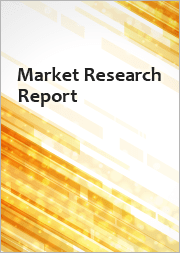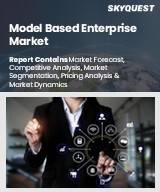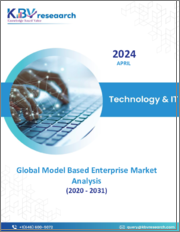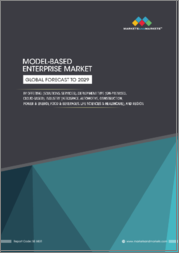
|
시장보고서
상품코드
1489332
모델 기반 기업(MBE) 시장 예측(-2030년) : 제공별, 도입 형태별, 최종사용자별, 지역별 세계 분석Model Based Enterprise Market Forecasts to 2030 - Global Analysis By Offering (Solutions, Services and Hardware), Deployment Mode, End User and By Geography |
||||||
세계의 모델 기반 기업(MBE) 시장 규모는 2023년에 116억 달러를 차지하며, 예측 기간 중 CAGR 16.9%로 성장하며, 2030년에는 347억 달러에 달할 것으로 예상되고 있습니다. 모델 기반 기업(MBE)은 제품수명주기관리(PLM)의 접근 방식으로, 디지털 모델을 제품 설계, 제조 및 관리를 위한 핵심 정보 소스로 사용하는 것을 강조하며, MBE 환경에서는 3D 디지털 모델이 제품 데이터의 권위 있는 소스 역할을 하여 기존의 2D 도면과 문서를 대체합니다. 도면과 문서를 대체합니다. 이 접근 방식은 협업을 촉진하고, 오류를 줄이며, 팀 간의 커뮤니케이션을 개선하고, 제품수명주기 전반에 걸쳐 의사결정을 강화합니다.
세계은행 추산에 따르면 2023년 32조 3,200억 달러였던 북미의 GDP는 2023-24년 1.5% 증가할 것으로 예상되며, 기업 활동과 모델 기반 기업 솔루션에 대한 투자가 활발해질 것으로 전망됩니다.
IoT 및 클라우드 기반 플랫폼 채택 증가
제조업 시장에서는 IoT 및 클라우드 기반 플랫폼의 채택이 급증하고 있습니다. IoT 기술은 실시간 모니터링과 제어를 가능하게 하고, 클라우드 플랫폼은 시스템에서 생성되는 방대한 양의 데이터를 저장하고 분석할 수 있는 확장 가능한 인프라를 제공합니다. 확장 가능한 인프라를 제공합니다. 이러한 융합은 기업이 제품을 설계, 생산, 관리하는 방식에 혁명을 일으켜 효율성과 혁신을 촉진할 준비가 되어 있습니다.
인식 부족
많은 기업, 특히 중소기업은 이러한 기술을 도입하여 프로세스를 간소화하고, 협업을 개선하고, 제품 품질을 향상시킬 수 있는 방법에 대해 잘 모르고 있습니다. 이러한 인식 부족은 종종 변화에 대한 저항과 이러한 기술 및 교육 프로그램에 대한 투자에 대한 소극적인 태도로 이어져 업계에서 이러한 혁신적인 접근 방식이 확산되는 것을 방해하고 있습니다. 따라서 인식 부족은 시장 성장을 저해하는 요인으로 작용하고 있습니다.
효율성과 생산성에 대한 니즈 증가
설계, 제조, 협업에서 디지털 모델에 대한 의존도가 높아짐에 따라 프로세스 최적화가 최우선 과제로 떠오르고 있습니다. 이해관계자들은 워크플로우를 간소화하고, 커뮤니케이션을 강화하며, 실수를 최소화하기 위해 첨단 툴와 기술을 활용하여 운영의 우수성을 끊임없이 추구하고 있습니다. 이러한 효율성 추구는 생태계내 비즈니스 운영과 혁신의 방식을 바꾸고 있으며, 빠른 발전과 경쟁력 차별화에 박차를 가하고 있습니다.
도입 비용
시장에서 도입 비용은 조직의 프로세스 복잡성, 도입 규모, 소프트웨어 및 기술 요구 사항, 교육 필요성과 같은 요인에 따라 크게 달라질 수 있습니다. 중소기업의 경우 수만 달러에서 수십만 달러, 대규모 통합 요구 사항과 사용자 정의가 필요한 대기업의 경우 수백만 달러를 MBE 도입에 투자할 수 있습니다. 이러한 비용에는 소프트웨어 라이선스, 컨설팅 서비스, 인프라 업그레이드, 지속적인 유지보수 등이 포함됩니다.
COVID-19의 영향
COVID-19 팬데믹은 시장에 큰 영향을 미쳤습니다. 제조업의 디지털 전환이 가속화되었고, 기업은 원격 근무를 위해 가상 협업 툴와 디지털 트윈 기술을 채택했습니다. 기업이 공급망을 효율적으로 관리하고 혼란 속에서 업무를 간소화하는 방법을 모색하면서 MBE 솔루션에 대한 수요가 급증했습니다. 그러나 인력 조정과 초기 투자 제약으로 인해 초기에는 시장 성장이 둔화됐지만, MBE 전략에 대한 인식이 높아지고 통합되면서 장기적인 전망은 여전히 낙관적입니다.
예측 기간 중 서비스 부문이 가장 큰 비중을 차지할 것으로 예상됩니다.
예측 기간 중 서비스 부문이 가장 큰 비중을 차지할 것으로 예상됩니다. 이러한 서비스에는 3D 모델링 및 시뮬레이션, CAD/CAM 소프트웨어 솔루션, 가상 프로토타이핑을 위한 디지털 트윈, 제품수명주기관리(PLM) 시스템, MBE 전략 수립을 위한 컨설팅 서비스 등이 포함됩니다. 또한 MBE 프로바이더는 기업이 모델 중심 접근 방식으로 전환하여 제품수명주기 전반에 걸쳐 효율성, 협업 및 혁신을 개선할 수 있도록 교육 및 지원을 제공합니다.
예측 기간 중 의료 부문이 가장 높은 CAGR을 나타낼 것으로 예상됩니다.
예측 기간 중 가장 높은 CAGR을 나타낼 것으로 예상되는 분야는 의료 부문입니다. 디지털 트윈 기술과 같은 MBE 기술을 통해 의료 조직은 데이터베이스 의사결정을 통해 운영을 간소화하고, 환자 치료를 강화하며, 혁신을 촉진할 수 있습니다. 고급 모델링과 시뮬레이션 기술을 통합함으로써 MBE는 의료 서비스 제공을 혁신하고 개인화된 치료, 질병 관리를 위한 예측 분석, 환자 결과의 전반적인 개선을 지원합니다.
가장 큰 점유율을 차지하는 지역
예측 기간 중 북미가 가장 큰 시장 점유율을 차지할 것으로 예상됩니다. 기업은 제품 개발을 간소화하고, 협업을 강화하며, 전체 제조 수명주기의 효율성을 향상시키는 전략을 채택하고 있습니다. 자동화 수요 증가, 품질관리의 중요성, 비용 효율적인 솔루션의 필요성 등이 시장 확대의 주요 요인으로 작용하고 있습니다. 이 지역의 주요 기업은 혁신적인 솔루션에 투자하여 시장 성장과 경쟁력 강화에 기여하고 있습니다.
CAGR이 가장 높은 지역
예측 기간 중 아시아태평양이 가장 높은 CAGR을 유지할 것으로 예상됩니다. 많은 국가들이 높은 제조 능력으로 유명합니다. 이러한 제조업체는 이러한 전략을 통해 경쟁력을 강화하고, 제품 품질을 개선하고, 시장 출시 시간을 단축하고, 생산 공정을 최적화할 수 있습니다. 자동차 산업과 항공우주 산업이 성장하고 있으며, 솔루션에 대한 수요를 주도하고 있습니다. 이들 분야는 설계, 시뮬레이션, 제조 및 유지보수 프로세스를 간소화하는 MBE의 능력으로 큰 이점을 얻을 수 있습니다.
무료 맞춤형 서비스 :
이 보고서를 구독하는 고객은 다음과 같은 무료 맞춤화 옵션 중 하나를 사용할 수 있습니다. :
- 기업 개요
- 추가 시장 기업 종합 프로파일링(최대 3사)
- 주요 기업의 SWOT 분석(최대 3사)
- 지역 세분화
- 고객의 관심에 따른 주요 국가별 시장 추정치, 예측, CAGR(주: 타당성 확인에 따름)
- 경쟁사 벤치마킹
- 제품 포트폴리오, 지역적 입지, 전략적 제휴를 기반으로 한 주요 기업 벤치마킹
목차
제1장 주요 요약
제2장 서문
- 개요
- 이해관계자
- 조사 범위
- 조사 방법
- 데이터 마이닝
- 데이터 분석
- 데이터 검증
- 조사 어프로치
- 조사 정보원
- 1차 조사 정보원
- 2차 조사 정보원
- 전제조건
제3장 시장 동향 분석
- 촉진요인
- 억제요인
- 기회
- 위협
- 최종사용자 분석
- 신흥 시장
- COVID-19의 영향
제4장 Porter's Five Forces 분석
- 공급 기업의 교섭력
- 구매자의 교섭력
- 대체품의 위협
- 신규 진출업체의 위협
- 경쟁 기업간 경쟁 관계
제5장 세계의 모델 기반 기업(MBE) 시장 : 제공별
- 솔루션
- Computer Aided Design(CAD) 소프트웨어
- 제품수명주기관리(PLM) 소프트웨어
- 시뮬레이션 소프트웨어
- 데이터 관리 소프트웨어
- 서비스
- 컨설팅
- 실장
- 트레이닝
- 하드웨어
- 3D 프린터
- 센서
- 스캐너
제6장 세계의 모델 기반 기업(MBE) 시장 : 도입 형태별
- 온프레미스
- 클라우드
- 하이브리드
제7장 세계의 모델 기반 기업(MBE) 시장 : 최종사용자별
- 항공우주 및 방위
- 자동차
- 전력과 에너지
- 건설
- 의료
- 기타 최종사용자
제8장 세계의 모델 기반 기업 시장 : 지역별
- 북미
- 미국
- 캐나다
- 멕시코
- 유럽
- 독일
- 영국
- 이탈리아
- 프랑스
- 스페인
- 기타 유럽
- 아시아태평양
- 일본
- 중국
- 인도
- 호주
- 뉴질랜드
- 한국
- 기타 아시아태평양
- 남미
- 아르헨티나
- 브라질
- 칠레
- 기타 남미
- 중동 및 아프리카
- 사우디아라비아
- 아랍에미리트
- 카타르
- 남아프리카공화국
- 기타 중동 및 아프리카
제9장 주요 발전
- 협정, 파트너십, 협업, 합병사업
- 인수합병
- 신제품 발매
- 사업 확대
- 기타 주요 전략
제10장 기업 프로파일링
- General Electric Company
- PTC Inc.
- Dassault Systemes SE
- Siemens AG
- SAP SE
- HCL Technologies Ltd.
- Wipro Limited
- ANSYS, Inc.
- General Electric Company
- Cisco Systems, Inc.
- Oracle Corporation
- HCL Technologies
- OpenText Corporation
- Penta Technologies
- Bentley Systems
According to Stratistics MRC, the Global Model Based Enterprise Market is accounted for $11.6 billion in 2023 and is expected to reach $34.7 billion by 2030 growing at a CAGR of 16.9% during the forecast period. Model-Based Enterprise (MBE) is an approach to product lifecycle management (PLM) that emphasizes the use of digital models as the central source of information for designing, manufacturing, and managing products. In an MBE environment, 3D digital models serve as the authoritative source of product data, replacing traditional 2D drawings and documents. This approach promotes collaboration, reduces errors, improves communication across teams, and enhances decision-making throughout the product lifecycle.
According to a World Bank estimate, the North American GDP, which was USD 32.32 trillion in 2023, is predicted to increase by 1.5% in 2023-24, suggesting that corporate activity and possible model-based enterprise solutions investments are projected to flourish.
Market Dynamics:
Driver:
Rising adoption of IoT and cloud-based platforms
The market is witnessing a surge in IoT and cloud-based platform adoption. This trend is driven by the need for enhanced connectivity, data analytics, and collaboration across manufacturing processes. IoT technologies enable real-time monitoring and control, while cloud platforms offer scalable infrastructure for storing and analyzing vast amounts of data generated by systems. This convergence is poised to revolutionize how enterprises design, produce, and manage products, driving efficiency and innovation.
Restraint:
Lack of awareness
Many businesses, especially smaller ones, remain uninformed about how adopting these enterprises can streamline processes, improve collaboration, and enhance product quality. This lack of awareness often leads to resistance to change and a reluctance to invest in these technologies and training programs, hindering the widespread adoption of these innovative approaches in the industry. Thus, the lack of awareness is the factor restraining the growth of the market.
Opportunity:
Growing need for efficiency and productivity
With industries increasingly relying on digital models for design, manufacturing, and collaboration, optimizing processes has become paramount. Stakeholders are leveraging advanced tools and technologies to streamline workflows, enhance communication, and minimize errors, driving a relentless pursuit of operational excellence. This emphasis on efficiency is reshaping how businesses operate and innovate within the ecosystem, fueling rapid advancements and competitive differentiation.
Threat:
Cost of implementation
In the market, the cost of implementation varies widely depending on factors like the complexity of the organization's processes, the scale of implementation, software and technology requirements, and training needs. Small to medium-sized enterprises may spend tens of thousands to hundreds of thousands of dollars, while larger corporations with extensive integration requirements and customization could invest millions in MBE implementation. These costs encompass software licensing, consulting services, infrastructure upgrades, and ongoing maintenance.
Covid-19 Impact:
The COVID-19 pandemic significantly impacted the market. It accelerated digital transformation in manufacturing, with companies adopting virtual collaboration tools and digital twin technologies for remote work. The demand for MBE solutions surged as businesses sought efficient ways to manage supply chains and streamline operations amidst disruptions. However, challenges such as workforce adjustments and initial investment constraints slowed down market growth initially, but the long-term outlook remains optimistic due to increased awareness and integration of MBE strategies.
The services segment is expected to be the largest during the forecast period
The services segment is expected to be the largest during the forecast period. These services include 3D modeling and simulation, CAD/CAM software solutions, digital twins for virtual prototyping, product lifecycle management (PLM) systems, and consulting services for implementing MBE strategies. Additionally, MBE providers offer training and support to help businesses transition to a model-centric approach, improving efficiency, collaboration, and innovation across the entire product lifecycle.
The healthcare segment is expected to have the highest CAGR during the forecast period
The healthcare segment is expected to have the highest CAGR during the forecast period. MBE methodologies like digital twin technology enable healthcare organizations to streamline operations, enhance patient care, and drive innovation through data-driven decision-making. By integrating advanced modelling and simulation techniques, MBE transforms healthcare delivery, supporting personalized treatments, predictive analytics for disease management, and overall improvement in patient outcomes.
Region with largest share:
North America is projected to hold the largest market share during the forecast period. Companies are increasingly adopting strategies to streamline product development, enhance collaboration, and improve efficiency across the manufacturing lifecycle. Key factors such as rising demand for automation, emphasis on quality control, and the need for cost-effective solutions are fueling market expansion. Major players in the region are investing in innovative solutions, further contributing to market growth and competitiveness.
Region with highest CAGR:
Asia Pacific is projected to hold the highest CAGR over the forecast period. Many countries are known for their manufacturing prowess. By implementing these strategies, these manufacturers can enhance their competitiveness, improve product quality, reduce time to market, and optimize production processes. The automotive and aerospace industries are expanding, driving the demand for solutions. These sectors benefit significantly from MBE's ability to streamline design, simulation, manufacturing, and maintenance processes.
Key players in the market
Some of the key players in Model Based Enterprise market include General Electric Company, PTC Inc., Dassault Systemes SE, Siemens AG, SAP SE, HCL Technologies Ltd., Wipro Limited, ANSYS, Inc., General Electric Company, Cisco Systems, Inc., Oracle Corporation, HCL Technologies, OpenText Corporation, Penta Technologies, Bentley Systems, Autodesk Inc. and Aras Corporation.
Key Developments:
In February 2024, Autodesk Inc. announced that the company had launched Autodesk Informed Design. This cloud-based solution connects design and manufacturing workflows to streamline the building design and construction process.
In February 2024, Aras announced that Johnson Matthey (JM) selected Aras Innovator to modernize its global PLM infrastructure and support its digital transformation strategy. Aras Innovator SaaS will be deployed as part of a multi-stage rollout beginning in the first quarter of 2024.
Offerings Covered:
- Solutions
- Services
- Hardware
Deployment Modes Covered:
- On-Premise
- Cloud
- Hybrid
End Users Covered:
- Aerospace & Defense
- Automotive
- Power & Energy
- Construction
- Healthcare
- Other End Users
Regions Covered:
- North America
- US
- Canada
- Mexico
- Europe
- Germany
- UK
- Italy
- France
- Spain
- Rest of Europe
- Asia Pacific
- Japan
- China
- India
- Australia
- New Zealand
- South Korea
- Rest of Asia Pacific
- South America
- Argentina
- Brazil
- Chile
- Rest of South America
- Middle East & Africa
- Saudi Arabia
- UAE
- Qatar
- South Africa
- Rest of Middle East & Africa
What our report offers:
- Market share assessments for the regional and country-level segments
- Strategic recommendations for the new entrants
- Covers Market data for the years 2021, 2022, 2023, 2026, and 2030
- Market Trends (Drivers, Constraints, Opportunities, Threats, Challenges, Investment Opportunities, and recommendations)
- Strategic recommendations in key business segments based on the market estimations
- Competitive landscaping mapping the key common trends
- Company profiling with detailed strategies, financials, and recent developments
- Supply chain trends mapping the latest technological advancements
Free Customization Offerings:
All the customers of this report will be entitled to receive one of the following free customization options:
- Company Profiling
- Comprehensive profiling of additional market players (up to 3)
- SWOT Analysis of key players (up to 3)
- Regional Segmentation
- Market estimations, Forecasts and CAGR of any prominent country as per the client's interest (Note: Depends on feasibility check)
- Competitive Benchmarking
- Benchmarking of key players based on product portfolio, geographical presence, and strategic alliances
Table of Contents
1 Executive Summary
2 Preface
- 2.1 Abstract
- 2.2 Stake Holders
- 2.3 Research Scope
- 2.4 Research Methodology
- 2.4.1 Data Mining
- 2.4.2 Data Analysis
- 2.4.3 Data Validation
- 2.4.4 Research Approach
- 2.5 Research Sources
- 2.5.1 Primary Research Sources
- 2.5.2 Secondary Research Sources
- 2.5.3 Assumptions
3 Market Trend Analysis
- 3.1 Introduction
- 3.2 Drivers
- 3.3 Restraints
- 3.4 Opportunities
- 3.5 Threats
- 3.6 End User Analysis
- 3.7 Emerging Markets
- 3.8 Impact of Covid-19
4 Porters Five Force Analysis
- 4.1 Bargaining power of suppliers
- 4.2 Bargaining power of buyers
- 4.3 Threat of substitutes
- 4.4 Threat of new entrants
- 4.5 Competitive rivalry
5 Global Model Based Enterprise Market, By Offering
- 5.1 Introduction
- 5.2 Solutions
- 5.2.1 Computer-Aided Design (CAD) Software
- 5.2.2 Product Lifecycle Management (PLM) Software
- 5.2.3 Simulation Software
- 5.2.4 Data Management Software
- 5.3 Services
- 5.3.1 Consulting
- 5.3.2 Implementation
- 5.3.3 Training
- 5.4 Hardware
- 5.4.1 3D Printers
- 5.4.2 Sensors
- 5.4.3 Scanners
6 Global Model Based Enterprise Market, By Deployment Mode
- 6.1 Introduction
- 6.2 On-Premise
- 6.3 Cloud
- 6.4 Hybrid
7 Global Model Based Enterprise Market, By End User
- 7.1 Introduction
- 7.2 Aerospace & Defense
- 7.3 Automotive
- 7.4 Power & Energy
- 7.5 Construction
- 7.6 Healthcare
- 7.7 Other End Users
8 Global Model Based Enterprise Market, By Geography
- 8.1 Introduction
- 8.2 North America
- 8.2.1 US
- 8.2.2 Canada
- 8.2.3 Mexico
- 8.3 Europe
- 8.3.1 Germany
- 8.3.2 UK
- 8.3.3 Italy
- 8.3.4 France
- 8.3.5 Spain
- 8.3.6 Rest of Europe
- 8.4 Asia Pacific
- 8.4.1 Japan
- 8.4.2 China
- 8.4.3 India
- 8.4.4 Australia
- 8.4.5 New Zealand
- 8.4.6 South Korea
- 8.4.7 Rest of Asia Pacific
- 8.5 South America
- 8.5.1 Argentina
- 8.5.2 Brazil
- 8.5.3 Chile
- 8.5.4 Rest of South America
- 8.6 Middle East & Africa
- 8.6.1 Saudi Arabia
- 8.6.2 UAE
- 8.6.3 Qatar
- 8.6.4 South Africa
- 8.6.5 Rest of Middle East & Africa
9 Key Developments
- 9.1 Agreements, Partnerships, Collaborations and Joint Ventures
- 9.2 Acquisitions & Mergers
- 9.3 New Product Launch
- 9.4 Expansions
- 9.5 Other Key Strategies
10 Company Profiling
- 10.1 General Electric Company
- 10.2 PTC Inc.
- 10.3 Dassault Systemes SE
- 10.4 Siemens AG
- 10.5 SAP SE
- 10.6 HCL Technologies Ltd.
- 10.7 Wipro Limited
- 10.8 ANSYS, Inc.
- 10.9 General Electric Company
- 10.10 Cisco Systems, Inc.
- 10.11 Oracle Corporation
- 10.12 HCL Technologies
- 10.13 OpenText Corporation
- 10.14 Penta Technologies
- 10.15 Bentley Systems






